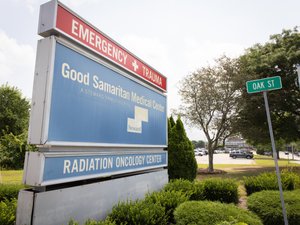Editor's note: BostInno's 3rd annual State of Innovation brings together more than 1,000 business leaders and professionals for keynotes from high-profile speakers, cutting-edge panel discussions with industry leaders, engaging workshops and endless networking opportunities. This year, a series of workshops with partner General Assembly will focus on skills needed to fuel Boston's growth, including design thinking.
There's no singular definition to describe the state of Boston innovation. Depending on the industry vantage point from which one views it, innovation in Boston can easily be characterized in a number of different ways. But for innovation to be positive and impactful, it has to be sustainable. And sustainability begins with design.
The creative process varies from person to person, mind to mind and for many, it's like a closed circle – there's no real beginning and no real end. So to help put together a better picture of what successful, sustainable innovation looks like in Boston, we reached out to three local designers.
They shared with us details on how they put themselves in a visionary mindset, create a productive atmosphere and on their favorite item that they've ever created.
Nina Chase is a landscape architect at Sasaki Associates.
Haril Pandya is a principal at CBT Architects.
Michael LeBlanc is a principal at Utile Inc.
Nick DeLuca: What's the very first part of your creative process?
Nina: Lots of research. My team and I start every project with a heavy dose of analysis, observing and documenting how a place looks, feels, and works: How are people currently using the space? What's happening in the surrounding neighborhood? What are the environmental conditions? What are the construction constraints? Every project is an opportunity to do something unique in the city, so at the same time, we're doing research to create a vision for the highest and best use of the future space: What is the future character of the space? What design problems are being solved? Are there other places with similar design problems? How can our space be different and innovative? It is the intersection of what exists and what could be that is exciting to me.
Haril: The very first part of our creative process is to listen to the client and understand the value they are looking for. They may have come to us with specific solutions in mind, but I am more focused (initially) in the desired outcome – both economically and the end design goals. What's most important to us is indentifying thte ways in which we can unlock value in our clients' buildings.
Michael: Identifying the limitations/parameters and finding the creative angle.
Describe your work space
Nina: Our office is an airy 100,000 sq. ft. mill building in the Charles River Mill District in Watertown. Sasaki acquired the building in 1975 and has since turned it into a beautiful office space. We have an open office layout with shared workspaces and lots of collaboration space for team reviews and pin-ups. There is a constant climate of learning in the office, it always feels very lively and inspiring. Our building is located adjacent to the Watertown Dam on the Charles River, so wildlife watching is a plus. Right now the dam is a mecca for seagulls feeding on alewife fish migrating up the Charles River. Last year a gigantic river turtle laid its eggs next to my window. Never a dull moment!
Haril: Our office located at 110 Canal Street is designed as an open/collaborative environment that fuels and allows conversations, collaboration, distruptive forward-thinking ideas and a constant flow of production. We occupy multiple floors in our buildings and have different styles of working – from closed offices to cublivles to benching. We truly practice what we preach.
Michael: For our first, smaller space I would say DaVinci’s Last Supper (no religious connotations implied). For our current space I would say DaVinci’s Last Supper meets the Apple Store. Everyone around a large table soaking up the zeitgeist of the office behind floor to ceiling glass storefront.
Is it difficult to turn off the design-mindedness after work hours?
Nina: On the contrary, my work and non-work life tend to merge pretty seamlessly. As a designer of spaces, I'm constantly inspired by my surroundings. In addition to the environments in which I live and work, the juxtaposition of "Boston area issues" such as the need for public open space, sea level rise/coastal flood resiliency, and environmental/sustainability topics influence my work.
Haril: We are all designers at heart – from how we work, live and and dress. I don't think it's a switch we can turn on or off. If it were, the switch would always remain on and locked in "creative mode."
Michael: At the onset of a project when the big picture wheels are turning yes it’s very difficult. At a certain point when the Parti has been established and the vision is set it becomes easier to turn it off. Having kids also helps to be a distraction from 24/7 design thinking.
Are you ever satisfied/unsatisfied with a final product?
Nina: Like with many creative processes, it always feels like there is more you can do on every project. But when I see people enjoying themselves in a place I designed I know it's a success. A couple weeks ago I went to the opening of the most recent Sasaki project I worked on, the Lawn on D, commissioned by the Massachusetts Convention Center Authority (MCCA). It was packed! People were hanging out, eating, drinking, dancing, playing bocce. There was even a line to get into the park! As a landscape architect, it was a proud moment, I never thought I'd see the day.
Haril: Designs have to achieve their goal. If the end product is impactful, transformative, beautiful and functional, then it has done its job. We want to repeat clients and happy end users as we are in the long term relationship business. If we could spend endless time on a project, we would because we can always continue to learn and modify to create improvements. However, economics tend to stop that quickly.
Michael: Always! Inevitably there will be opportunities which you miss either because your focus was redirected to deal with some specific problem which arises mid-process or because the obvious answer simply escaped without being revealed. That said, there is always such a sense of excitement as a building starts to take shape and as it closes in on being complete. When you can walk through a building and experience it as you had envisioned it in your head for so long it is very satisfying.
Choose between your children: What's your favorite thing you've ever designed and describe it in one word.
Nina: It's hard to choose. I've worked with many great people on great projects in great locations, but I can't help feeling especially proud of the Lawn on D. Now that we finally have great weather, I'll be spending a lot of time there – The Lawn on D, in one word: Experimental.
Haril: The next project. One word? FUTURITY
Michael: The Moose Hill House. It’s remarkably “Utile!”








